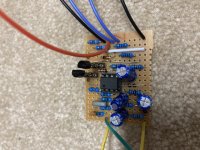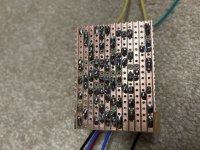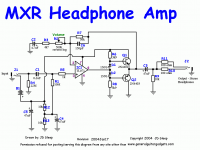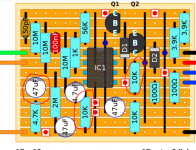BuddytheReow
Breadboard Baker
Hey Guys,
Need a little help with this stripboard build. I want to attach this one right after a 6 Pot EQ board for some portable practice, but am not getting any sound out of this. My voltages are as follows. The build calls for 2n4401 and 2n4403, but I substituted with 2n3904 since I had them. With an audio probe I get signal into IC pin 3 and occasionally out pin 6. I tried swapping out the TL071 but no change. I did swipe my solder iron down the tracks to get any potential solder off, but I'm posting some pictures just in case. I couldn't test the 10m and 2m resistors since my multimeter is cheap and can't measure that big, but the color rings on them match what the value is supposed to be.
Heres a link for the schematic. http://www.generalguitargadgets.com/pdf/ggg_mxr_hpamp_sc.pdf
IC Pin 1 - 0.25
IC Pin 2 - 3.4
IC Pin 3 - 1.11
IC Pin 4 - 0
IC Pin 5 - 0
IC Pin 6 - 8.27
IC Pin 7 - 9
IC Pin 8 - 0
Q1 B - 4
Q1 C - 9
Q1 E - 3.5
Q2 B - 0
Q2 C - 2.8
Q2 E - 3.5
Diodes 2.3v and 1.7v on each side
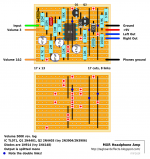
Need a little help with this stripboard build. I want to attach this one right after a 6 Pot EQ board for some portable practice, but am not getting any sound out of this. My voltages are as follows. The build calls for 2n4401 and 2n4403, but I substituted with 2n3904 since I had them. With an audio probe I get signal into IC pin 3 and occasionally out pin 6. I tried swapping out the TL071 but no change. I did swipe my solder iron down the tracks to get any potential solder off, but I'm posting some pictures just in case. I couldn't test the 10m and 2m resistors since my multimeter is cheap and can't measure that big, but the color rings on them match what the value is supposed to be.
Heres a link for the schematic. http://www.generalguitargadgets.com/pdf/ggg_mxr_hpamp_sc.pdf
IC Pin 1 - 0.25
IC Pin 2 - 3.4
IC Pin 3 - 1.11
IC Pin 4 - 0
IC Pin 5 - 0
IC Pin 6 - 8.27
IC Pin 7 - 9
IC Pin 8 - 0
Q1 B - 4
Q1 C - 9
Q1 E - 3.5
Q2 B - 0
Q2 C - 2.8
Q2 E - 3.5
Diodes 2.3v and 1.7v on each side

Attachments
Last edited:


